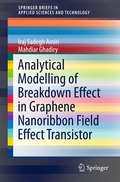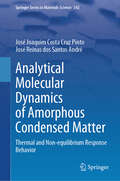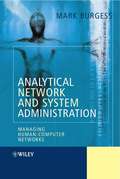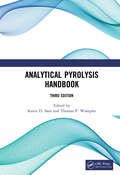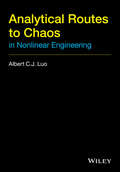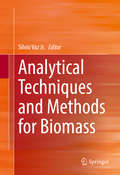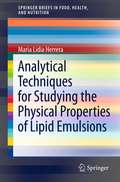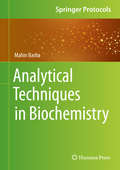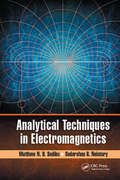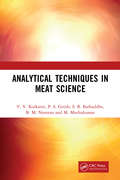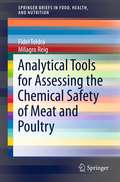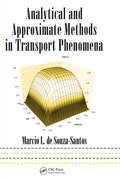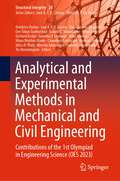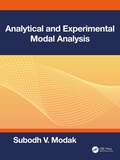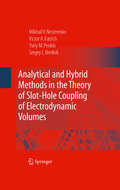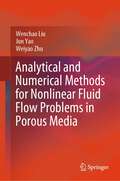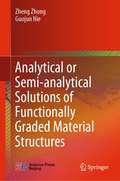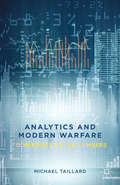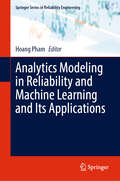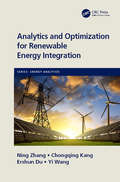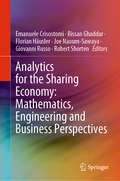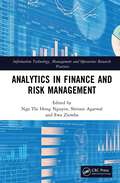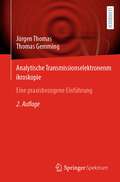- Table View
- List View
Analytical Modelling of Breakdown Effect in Graphene Nanoribbon Field Effect Transistor (SpringerBriefs in Applied Sciences and Technology)
by Iraj Sadegh Amiri Mahdiar GhadiryThis book discusses analytical approaches and modeling of the breakdown voltage (BV) effects on graphene-based transistors. It presents semi-analytical models for lateral electric field, length of velocity saturation region (LVSR), ionization coefficient (α), and breakdown voltage (BV) of single and double-gate graphene nanoribbon field effect transistors (GNRFETs). The application of Gauss's law at drain and source regions is employed in order to derive surface potential and lateral electric field equations. LVSR is then calculated as a solution of surface potential at saturation condition. The ionization coefficient is modelled and calculated by deriving equations for probability of collisions in ballistic and drift modes based on the lucky drift theory of ionization. The threshold energy of ionization is computed using simulation and an empirical equation is derived semi-analytically. Lastly avalanche breakdown condition is employed to calculate the lateral BV. On the basis of this, simple analytical and semi-analytical models are proposed for the LVSR and BV, which could be used in the design and optimization of semiconductor devices and sensors. The proposed equations are used to examine BV at different channel lengths, supply voltages, oxide thickness, GNR widths, and gate voltages. Simulation results show that the operating voltage of FETs could be as low as 0. 25 V in order to prevent breakdown. However, after optimization, it can go as high as 1. 5 V. This work is useful for researchers working in the area of graphene nanoribbon-based transistors.
Analytical Molecular Dynamics of Amorphous Condensed Matter: Thermal and Non-equilibrium Response Behavior (Springer Series in Materials Science #342)
by José Joaquim Costa Cruz Pinto José Reinas dos Santos AndréThe book provides a detailed quantitative study and characterization of the physics of the thermal and viscoelastic behavior of mainly amorphous materials, and addresses a readership of both undergraduate (Part I and the two first chapters of Part II) and graduate students and junior researchers (Parts II and III). Though the discussion and examples concentrate on polymer materials, Part II illustrates the potential universality of the proposed most recent treatment – a Cooperative Theory of Materials Dynamics (CTMD) – and its ability to portray the 11 major physical characteristics of the materials' behavior by an alternative view of the thermal equilibrium and non-equilibrium dynamics at the "micro-scale", the still challenging problem of the glass transition and glass transition temperature, how partial crosslinking or crystallization limits the response, the expected impact of molecular packing, and of a few other open challenges. Part III discusses three specific domains where new applications and extensions of CTMD might be explored, while three Appendixes collect a few quantitative details and extensions of the treatment.
Analytical Network and System Administration
by Mark BurgessNetwork and system administration usually refers to the skill of keeping computers and networks running properly. But in truth, the skill needed is that of managing complexity. This book describes the science behind these complex systems, independent of the actual operating systems they work on. It provides a theoretical approach to systems administration that:saves time in performing common system administration tasks.allows safe utilization of untrained and trained help in maintaining mission-critical systems.allows efficient and safe centralized network administration.Managing Human-Computer Networks:Will show how to make informed analyses and decisions about systems, how to diagnose faults and weaknessesGives advice/guidance as to how to determine optimal policies for system managementIncludes exercises that illustrate the key points of the bookThe book provides a unique approach to an old problem and will become a classic for researchers and graduate students in Networking and Computer Science, as well as practicing system managers and system administrators.
Analytical Pyrolysis Handbook
by Karen D. SamAnalytical pyrolysis allows scientists to use routine laboratory instrumentation for analyzing complex, opaque, or insoluble samples more effectively than other analytical techniques alone. Analytical Pyrolysis Handbook, Third Edition is a practical guide to the application of pyrolysis techniques to various samples and sample types for a diversity of fields including microbiology, forensic science, industrial research, and environmental analysis. The much-anticipated third edition incorporates recent technological advances that increase the technique’s sensitivity to trace elements, improve its reproducibility, and expand its applicability. The book reviews the types of instrumentation available to perform pyrolysis and offers guidance for interfacing instruments and integrating other analytical techniques, including gas chromatography and mass spectrometry. Fully updated with new sample pyrograms, figures, references, and real-world examples, this edition also highlights new areas of application including cultural materials, forensic analysis, and environmental studies. This book illustrates how the latest advances make pyrolysis a practical, cost-effective, reliable, and flexible alternative for increasingly complex sample analyses. Analytical Pyrolysis Handbook, Third Edition is an essential, one-stop guide for determining if pyrolysis meets application-specific needs as well as performing pyrolysis and handling the data obtained.
Analytical Routes to Chaos in Nonlinear Engineering
by Albert C. LuoNonlinear problems are of interest to engineers, physicists and mathematicians and many other scientists because most systems are inherently nonlinear in nature. As nonlinear equations are difficult to solve, nonlinear systems are commonly approximated by linear equations. This works well up to some accuracy and some range for the input values, but some interesting phenomena such as chaos and singularities are hidden by linearization and perturbation analysis. It follows that some aspects of the behavior of a nonlinear system appear commonly to be chaotic, unpredictable or counterintuitive. Although such a chaotic behavior may resemble a random behavior, it is absolutely deterministic. Analytical Routes to Chaos in Nonlinear Engineering discusses analytical solutions of periodic motions to chaos or quasi-periodic motions in nonlinear dynamical systems in engineering and considers engineering applications, design, and control. It systematically discusses complex nonlinear phenomena in engineering nonlinear systems, including the periodically forced Duffing oscillator, nonlinear self-excited systems, nonlinear parametric systems and nonlinear rotor systems. Nonlinear models used in engineering are also presented and a brief history of the topic is provided. Key features: Considers engineering applications, design and control Presents analytical techniques to show how to find the periodic motions to chaos in nonlinear dynamical systems Systematically discusses complex nonlinear phenomena in engineering nonlinear systems Presents extensively used nonlinear models in engineering Analytical Routes to Chaos in Nonlinear Engineering is a practical reference for researchers and practitioners across engineering, mathematics and physics disciplines, and is also a useful source of information for graduate and senior undergraduate students in these areas.
Analytical Techniques and Methods for Biomass
by Sílvio Vaz Jr.This book deals with the application of techniques and methods of chemical analysis for the study of biomass and its conversion processes, aiming to fill the current gap in the book literature on the subject. The use of various techniques and analytical methods is presented and discussed in a straightforward manner, providing the reader with the possibility of choosing the most appropriate methodologies for analysis of the major classes of plant biomass and its products. In the present volume, a select group of international specialists describes different approaches to understand the biomass structure, their physical and chemical properties, the parameters of conversion processes, the products and by-products formation and quantification, quality parameters, etc. Modern chemistry plays a strong economic role in industrial activities based on biomass, with an increasing trend of the importance of its application from the deployment of biorefineries and the principles of green chemistry, which make use of the potential of biomass with decreasing impact negative environmental. In this context, analytical chemistry can contribute significantly to the supply chains of biomass, be it plant or animal origin; however, with the first offering the greatest challenges and the greatest opportunity for technical, scientific and economic progress, given its diversified chemical constitution. Thus, the chemical analysis can be used to examine the composition for characterizing physicochemical properties and to monitor their conversion processes, in order to obtain better products and uses of biomass. The quality of the biomass used determines the product quality. Therefore, reliable information is required about the chemical composition of the biomass to establish the best use (e. g. , most suitable conversion process and its conditions), which will influence harvest and preparation steps. Conversion processes should be monitored for their yield, integrity, safety, and environmental impact. Effluent or residues should be monitored and analyzed for environmental control. Co-products need to be monitored to avoid interference with the product yield and product purity; however, co-products are also a good opportunity to add value to the biomass chain. Finally, products need to be monitored and analyzed to determine their yields and purity and to ensure their quality. In this context, analytical chemistry can contribute significantly to the biomass supply chains, be it of plant or animal origin.
Analytical Techniques for Studying the Physical Properties of Lipid Emulsions (SpringerBriefs in Food, Health, and Nutrition #3)
by Maria Lidia HerreraThis book will review old and new methods to study emulsion stability and structure. Examples of emulsion-based foods include ice cream, yoghurt, and mayonnaise. The physicochemical properties of emulsions play an important role in food systems, as they directly contribute to the texture, sensory and nutritional properties of foods. One of the main properties is stability, which refers to the ability of an emulsion to resist physical changes over time. The development of an effective strategy to prevent undesirable changes in the properties of a particular food emulsion depends on the dominant physicochemical mechanism(s) responsible for the changes. In practice, two or more of these mechanisms may operate in concert. It is therefore important for food scientists to identify the relative importance of each mechanism, the relationship between them, and the factors that influence them, so that effective means of controlling the stability and physicochemical properties of emulsions can be established. Several techniques are used to study the physical behavior and structure of emulsions. Each technique has its advantages and disadvantages and provides different insights into the destabilization mechanisms. Among the oldest methods used to study emulsion stability is visual observation and small deformation rheometry. More recently, other techniques, such as ultrasound profiling, microscopy, droplet size distribution, and measurement of surface concentration to characterize adsorbed protein at the interface, have also been employed. Some of these techniques, such as droplet size distribution, involve some form of dilution. However, dilution disrupts some structures that play an important role in stability. The ability to study the stability of food emulsions in their undiluted form may reveal subtle nuances about their stability. Diffusing wave spectroscopy (DWS), laser scanning confocal microscopy (LSCM), nuclear magnetic resonance (NMR), and Turbiscan are among the more powerful, non-perturbing techniques used to characterized emulsions.
Analytical Techniques in Biochemistry (Springer Protocols Handbooks)
by Mahin BashaThis book provides a comprehensive overview of the major biochemical analytical techniques, with detailed descriptions of the instrumentation and applications. The contributions, which each focus on a specific technique, are based on a thorough review and analysis of the current literature as well as the authors’ experiences in the lab. Divided into nine parts, the book provides insights into basic separation techniques like sedimentation, filtration and centrifugation, as well as analytical techniques such as spectrophotometry, chromatography, electrophoresis, immuno-techniques, radioactivity and microscopy.
Analytical Techniques in Electromagnetics
by Matthew N. Sadiku Sudarshan R. NelaturyAnalytical Techniques in Electromagnetics is designed for researchers, scientists, and engineers seeking analytical solutions to electromagnetic (EM) problems. The techniques presented provide exact solutions that can be used to validate the accuracy of approximate solutions, offer better insight into actual physical processes, and can be utilized
Analytical Techniques in Meat Science
by M. Muthukumar V. V. Kulkarni P. S. Girish S. B. Barbuddhe B. M. NaveenaAnalytical Techniques in Meat Science is a comprehensive compilation of all the relevant methodologies for the quality analysis of meat. The content of the book is designed to cater to requirement of meat producers, regulatory agencies, researchers, students, teachers, laboratory staff etc. It covers techniques for physico-chemical analysis, speciesidentification and microbiological examination of meat. Also, it contains the latest biotechnological and proteomic techniques for meat quality evaluation. To help the reader understand better figures, tables, line diagrams, etc are used frequently whenever needed. Some important pictures are given in plates for lucid and clear understanding of theconcept.Note: T&F does not sell or distribute the hardback in India, Pakistan, Nepal, Bhutan, Bangladesh and Sri Lanka.
Analytical Tools for Assessing the Chemical Safety of Meat and Poultry (SpringerBriefs in Food, Health, and Nutrition #9)
by Fidel Toldrá Milagro ReigThe goal of the Brief is to summarize the state of the art on the chemical safety issues currently concerning meat and poultry, and to discuss the current international legislation on the tools available for their control. The Brief will review the analytical controls and instrumentation available for the control of residues of growth promoters, antibiotics, and any other environmental substances in raw meat and poultry. In addition, there will be a discussion of both the substances that may be generated as a consequence of processing, and the tools that are available for their control. These substances may be quite varied in nature; they may include, for example, the heterocyclic amines generated by heating, the nitrosamines sometimes present in cured meats with nitrite if not properly processed, the polycyclic aromatic hydrocarbons that can be generated depending on the type of smoking used, or the biogenic amines that can be generated during fermentation. Finally, the controls for the detection of foreign proteins (e.g., whey proteins) in the final products will be also compiled. The Brief will conclude with a view of future trends and key references for readers interested in learning more about this topic.
Analytical Ultracentrifugation: Instrumentation, Software, and Applications
by Susumu Uchiyama Fumio Arisaka Walter F. Stafford Tom LaueThis book introduces analytical ultracentrifugation (AUC) as a whole, covering essential theoretical and practical aspects as well as its applications in both biological and non-biological systems. Comprehensive characterizations of macromolecules in a solution are now routinely required not only for understanding the solution system but also for producing a solution with better properties. Analytical ultracentrifugation is one of most powerful and reliable techniques for studying the biophysical behavior of solutes in solution. In the last few years, there have been steady advances made in hardware, software, and applications for AUC. This book provides chapters that cover everything essential for beginners to the most advanced users and also offer updated knowledge of the field on advances in hardware, software, and applications. Recent development of hardware described in this book covers new detection systems that give added dimensions to AUC. Examples of data analysis with essential theoretical explanations for advanced and recently updated software are also introduced. Besides AUC of biological systems including membrane proteins and biopharmaceuticals, AUC applications for non-biological questions are included. AUC studies under non-ideal conditions such as highly concentrated solutions and solutions with high salt concentration are also included. The contributors to this book are leading researchers in the fields of solution biophysics and physical chemistry who extensively employ AUC analysis for their research. From this published work, one can gain new and comprehensive knowledge of recent AUC analysis.
Analytical and Approximate Methods for Complex Dynamical Systems (Understanding Complex Systems)
by Alexander TimokhaThis book presents Analytical and Approximate Methods for Complex Dynamical Systems and introduces ideas of discontinuous mapping treated as complex dynamical systems. Mathematicians of world-recognized Ukrainian scientific schools established by M.Krylov, M.Bogolyubov, Yu.Mitropolskiy, and A.Sharkovsky used to cooperate for writing the collective book whose purpose consists of illustrating a synergy of combining diverse (by idea and technique) constructive analytical and approximate approaches and methods in complex dynamical systems which are herein associated with mathematical models of networks, conflict/economic theories, sloshing, soft matter, and even levitating drops. Readers are facilitated to learn contemporary insights, fundamentals (Parts I and III), applications (Part II), and components of theories of bifurcation, synchronization/self-organization, collective dynamics, chaos, solitons, fractional differential equations, symmetry, reduced order modelling, and many others, that makes the book useful for both graduate and postgraduate students, lecturers, researchers, and even engineers dealing with multidimensional dynamic systems.
Analytical and Approximate Methods in Transport Phenomena
by Marcio L. de Souza-SantosOn the job or in the field, when facing a problem with differential equations and boundary conditions, most likely you don't have time to read through several publications in search of a method that may or may not solve your problem. Organized for quick and easy access to practical solutions, Analytical and Approximate Methods in Transport Pheno
Analytical and Experimental Methods in Mechanical and Civil Engineering: Contributions of the 1st Olympiad in Engineering Science (OES 2023) (Structural Integrity #28)
by Gerhard Ersdal Jayantha P. Liyanage Dimitrios Pavlou Jose A. F. O. Correia Tiago Fazeres-Ferradosa Ove Tobias Gudmestad Sudath C. Siriwardane Hirpa Lemu Vidar Hansen Mona Wetrhus Minde Chandima Ratnayake Andreas Delimitis Idriss El-Thalji Nirosha Adasooriya Samindi Samarakoon Tor HemmingsenThis book publishes contributions of the 1st Olympiad in Engineering Science (OES 2023), an international congress and contest aiming to disseminate and evaluate the recent advances in Engineering Science. The book is divided in several parts. In 'Materials Science,' readers delve into nanostructural correlations in thermochromic VO2 thin films for smart windows, as well as microstructural observations of super duplex stainless steel. The 'Marine Technology' part explores riverbed scour, wave reflection, and innovative nature-based solutions for coastal protection. 'Additive Manufacturing and Welding Technology' delves into studies on carbon fiber-reinforced polymers and fatigue properties of 3D-printed specimens. 'Structural Integrity and Structural Health Monitoring' offers insights into offshore pipeline fatigue life prediction and risk-informed decision-making for existing structures. The 'Non-destructive Testing and Evaluation' part encompasses stress monitoring, rail profile measurement, and health-monitoring approaches for debonding diagnosis. 'Dynamics and Vibrations' ventures into investigations on combined viscous and Coulomb damped systems and seismic signal analysis for landslides. 'Materials Engineering' delves into strengthening reinforced concrete members and dynamic properties of carbon fiber-reinforced polymers. 'Building Materials and Concrete Structures' cover topics like minibar reinforced concrete, impact response of reinforced columns, and residual strength of cement-based composites. 'Electronic Sensors and Intelligent Systems' showcase simulations under high voltage transmission lines, synthesis of BaxSr(1-x)TiO3, and antenna catheter modeling. 'Asset Integrity' discusses analytical and experimental analyses of buckling in aluminum columns and I-beams, lateral-torsional buckling capacity, and modulation of fluid streams. Finally, 'Climate Change and Circular Economy' addresses climate-adaptive design, circular economy integration, and eco-innovative concrete applications with recycled materials. This book provides a comprehensive overview of cutting-edge research and advancements in mechanical and civil engineering, offering valuable insights for researchers, practitioners, and enthusiasts in the field.
Analytical and Experimental Modal Analysis
by Subodh V. ModakThis book covers the fundamentals and basic concepts of analytical and experimental approaches to modal analysis. In practice, the analytical approach based on lumped parameter and finite element models is widely used for modal analysis and simulation, and experimental modal analysis is widely used for modal identification and model validation. This book is inspired by this consideration and is written to give a complete picture of modal analysis. Features: Presents a systematic development of the relevant concepts and methods of the analytical and experimental modal analyses. Covers phase resonance testing and operational modal analysis. Provides the relevant signal processing concepts. Includes applications like model validation and updating, force identification and structural modification. Contains simulations, examples, and MATLAB® programs to enhance understanding. This book is aimed at senior undergraduates/graduates, researchers, and engineers from mechanical, aerospace, automotive, civil, and structural engineering disciplines.
Analytical and Hybrid Methods in the Theory of Slot-Hole Coupling of Electrodynamic Volumes
by Victor A. Katrich Yuriy M. Penkin Sergey L. BerdnikThis book provides the reader with the possibility of rapid study and application of methods of computer analysis of electrodynamic problems. The authors address the development of analytical methods to solve the problems of diffraction of waveguide electromagnetic waves on slot coupling holes. All the authors have experience in the field and the topics addressed are based on their original research results. The book is written in a laconic style and is visually accessible.
Analytical and Numerical Methods for Nonlinear Fluid Flow Problems in Porous Media
by Weiyao Zhu Jun Yao Wenchao LiuThis book investigates in detail the mathematical methods and computation methods in efficient solution of some open nonlinear seepage flow problems involved in engineering problems. Developed engineering technologies and some relevant practical field applications are also provided. The introduced open nonlinear problems include nonlinear quadratic pressure gradient term problem, compressible gas seepage flow problem and low-velocity non-Darcy seepage flow problem. Studies on these nonlinear seepage flow problems have attracted engineers and scientists from various disciplines, such as geo-energy engineering, civil and environmental engineering, fluid mechanics, applied mathematics and computation. In particular, the book systematically establishes a fundamental theory for a strongly nonlinear problem of low-velocity non-Darcy seepage flow from a new perspective of moving boundary, while emphasizing the usage of mathematical linearization transformation methods and computational methods into the analytical and numerical solution of the strongly nonlinear partial differential equations. Sufficient knowledge of mathematics is always introduced ahead of model solution to assist readers. And the procedure of strict formula deduction in the model solution process is provided in detail. High-solution figures and tables from model solution are rich in the book. Therefore, it is very helpful for the readers to master the nonlinear model solution methods and engineering technologies. The book is intended for upper undergraduate students and graduate students who are interested in engineering technology, fluid mechanics and applied mathematics, researchers and engineers working on geo-energy science and engineering and field applications.
Analytical or Semi-analytical Solutions of Functionally Graded Material Structures
by Zheng Zhong Guojun NieThis book provides a comprehensive introduction to the analysis of functionally graded materials and structures. Functionally graded materials (FGMs), in which the volume fractions of two or more constituent materials are designed to vary continuously as a function of position along certain direction(s), have been developed and studied over the past three decades. The major advantage of FGMs is that no distinct internal boundaries exist, and failures from interfacial stress concentrations developed in conventional components can be avoided. The gradual change of material properties can be tailored to different applications and working environments. As these materials’ range of application expands, new methodologies have to be developed to characterize them, and to design and analyze structural components made of them.Despite a number of existing papers on the analysis of functionally graded materials and structures, there is no single book that is devoted entirely to the analysis of functionally graded beams, plates and shells using different methods, e.g.,analytical or semi-analytical methods.Filling this gap in the literature, the book offers a valuable reference resource for senior undergraduates, graduate students, researchers, and engineers in this field. The results presented here can be used as a benchmark for checking the validity and accuracy of other numerical solutions. They can also be used directly in the design of functionally graded materials and structures.
Analytics And Modern Warfare: Dominance by the Numbers
by Michael TaillardThis book details very simply and for even the most novice of potential analysts not only how to perform analytics which describe what is happening, predict what is going to happen, and optimize responses, but also places these analytics in the context of proactive strategy development.
Analytics Modeling in Reliability and Machine Learning and Its Applications (Springer Series in Reliability Engineering)
by Hoang PhamThis book presents novel research and application chapters on topics in reliability, statistics, and machine learning. It has an emphasis on analytical models and techniques and practical applications in reliability engineering, data science, manufacturing, health care, and industry using machine learning, AI, optimization, and other computational methods. Today, billions of people are connected to each other through their mobile devices. Data is being collected and analysed more than ever before. The era of big data through machine learning algorithms, statistical inference, and reliability computing in almost all applications has resulted in a dramatic shift in the past two decades. Data analytics in business, finance, and industry is vital. It helps organizations and business to achieve better results and fact-based decision-making in all aspects of life. The book offers a broad picture of current research on the analytics modeling and techniques and its applications in industry. Topics include: l Reliability modeling and methods. l Software reliability engineering. l Maintenance modeling and policies. l Statistical feature selection. l Big data modeling. l Machine learning: models and algorithms. l Data-driven models and decision-making methods. l Applications and case studies in business, health care, and industrial systems. Postgraduates, researchers, professors, scientists, engineers, and practitioners in reliability engineering and management, machine learning engineering, data science, operations research, industrial and systems engineering, statistics, computer science and engineering, mechanical engineering, and business analytics will find in this book state-of-the-art analytics, modeling and methods in reliability and machine learning.
Analytics and Optimization for Renewable Energy Integration (Energy Analytics)
by Ning Zhang Yi Wang Chongqing Kang Ershun DuThe scope of this book covers the modeling and forecast of renewable energy and operation and planning of power system with renewable energy integration.The first part presents mathematical theories of stochastic mathematics; the second presents modeling and analytic techniques for renewable energy generation; the third provides solutions on how to handle the uncertainty of renewable energy in power system operation. It includes advanced stochastic unit commitment models to acquire the optimal generation schedule under uncertainty, efficient algorithms to calculate the probabilistic power, and an efficient operation strategy for renewable power plants participating in electricity markets.
Analytics for the Sharing Economy: Mathematics, Engineering and Business Perspectives
by Giovanni Russo Emanuele Crisostomi Robert Shorten Bissan Ghaddar Florian Häusler Joe Naoum-SawayaThe book provides an encompassing overview of all aspects relating to the sharing economy paradigm in different fields of study, and shows the ongoing research efforts in filling previously identified gaps in understanding in this area. Control and optimization analytics for the sharing economy explores bespoke analytics, tools, and business models that can be used to help design collaborative consumption services (the shared economy). It provides case studies of collaborative consumption in the areas of energy and mobility.The contributors review successful examples of sharing systems, and explore the theory for designing effective and stable shared-economy models. They discuss recent innovations in and uses of shared economy models in niche areas, such as energy and mobility. Readers learn the scientific challenging issues associated with the realization of a sharing economy. Conceptual and practical matters are examined, and the state-of-the-art tools and techniques to address such applications are explained. The contributors also show readers how topical problems in engineering, such as energy consumption in power grids, or bike sharing in transportation networks, can be formulated and solved from a general collaborative consumption perspective. Since the book takes a mathematical perspective to the topic, researchers in business, computer science, optimization and control find it useful. Practitioners also use the book as a point of reference, as it explores and investigates the analytics behind economy sharing.
Analytics in Finance and Risk Management (Information Technology, Management and Operations Research Practices)
by Ewa Ziemba Shivani Agarwal Nga Thi Hong NguyenThis book presents contemporary issues and challenges in finance and risk management in a time of rapid transformation due to technological advancements. It includes research articles based on financial and economic data and intends to cover the emerging role of analytics in financial management, asset management, and risk management. Analytics in Finance and Risk Management covers statistical techniques for data analysis in finance It explores applications in finance and risk management, covering empirical properties of financial systems. It addresses data science involving the study of statistical and computational models and includes basic and advanced concepts. The chapters incorporate the latest methodologies and challenges facing financial and risk management and illustrate related issues and their implications in the real world. The primary users of this book will include researchers, academicians, postgraduate students, professionals in engineering and business analytics, managers, consultants, and advisors in IT firms, financial markets, and services domains.
Analytische Transmissionselektronenmikroskopie: Eine praxisbezogene Einführung
by Jürgen Thomas Thomas GemmingDas Buch wendet sich an alle, egal ob im Studium, in technischen Berufen, oder in der Wissenschaft, die die sich für die analytische Transmissionselektronenmikroskopie interessieren und einen Überblick über diese Methode erhalten möchten. Insbesondere betrifft dies Personen, die an einem Transmissionselektronenmikroskop arbeiten wollen oder müssen, die aber noch keine spezielle elektronenmikroskopische Ausbildung durchlaufen haben. Das Buch basiert auf den Erfahrungen der Autoren bei der Unterrichtung von Studierenden, Promovierenden und in technischen Berufen Tätigen. Der Überblick über die analytische Transmissionselektronenmikroskopie umfasst die Schwerpunkte Optische Abbildung, Elektronenwellen, magnetische Linsen, Abbildungsfehler, Aufbau eines Transmissionselektronenmikroskops, Präparation dünner Proben, Justage des Mikroskops, Elektronenbeugung, Kontrastentstehung, Höchstauflösungselektronenmikroskopie, Rastertransmissionselektronenmikroskopie sowie Analytik mittels energiedispersiver Röntgenspektroskopie und Elektronenenergieverlust-Spektroskopie. Ein mathematischer Anhang erklärt grundlegende Formalismen zur Thematik.
